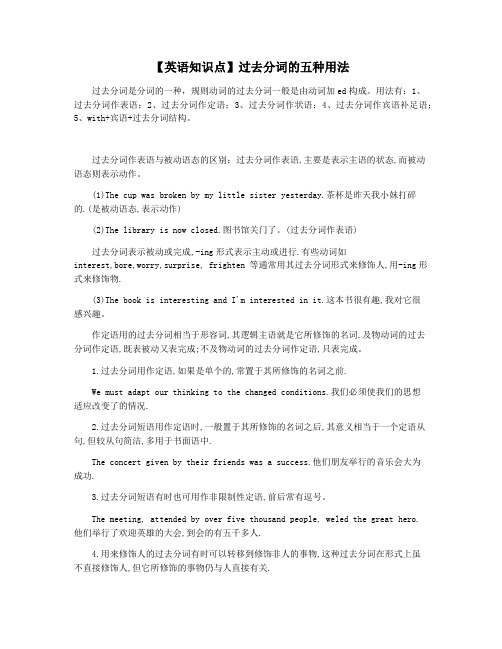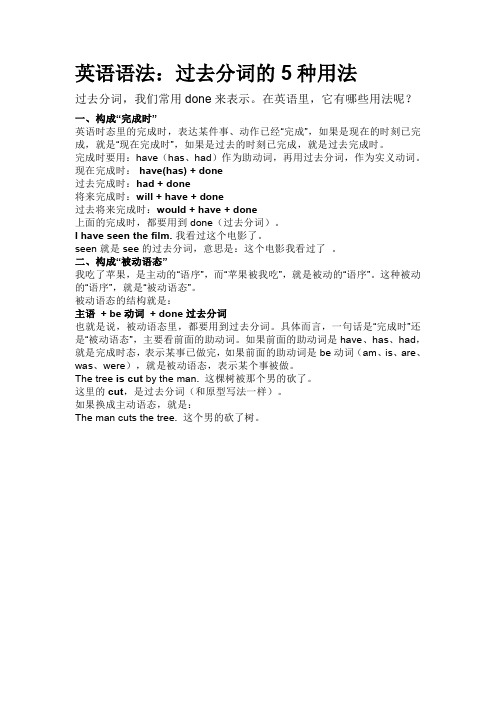过去分词用法归纳
- 格式:doc
- 大小:54.50 KB
- 文档页数:7

【英语知识点】过去分词的五种用法过去分词是分词的一种,规则动词的过去分词一般是由动词加ed构成。
用法有:1、过去分词作表语;2、过去分词作定语;3、过去分词作状语;4、过去分词作宾语补足语;5、with+宾语+过去分词结构。
过去分词作表语与被动语态的区别:过去分词作表语,主要是表示主语的状态,而被动语态则表示动作。
(1)The cup was broken by my little sister yesterday.茶杯是昨天我小妹打碎的.(是被动语态,表示动作)(2)The library is now closed.图书馆关门了。
(过去分词作表语)过去分词表示被动或完成,-ing形式表示主动或进行.有些动词如interest,bore,worry,surprise, frighten 等通常用其过去分词形式来修饰人,用-ing形式来修饰物.(3)The book is interesting and I'm interested in it.这本书很有趣,我对它很感兴趣。
作定语用的过去分词相当于形容词,其逻辑主语就是它所修饰的名词.及物动词的过去分词作定语,既表被动又表完成;不及物动词的过去分词作定语,只表完成。
1.过去分词用作定语,如果是单个的,常置于其所修饰的名词之前.We must adapt our thinking to the changed conditions.我们必须使我们的思想适应改变了的情况.2.过去分词短语用作定语时,一般置于其所修饰的名词之后,其意义相当于一个定语从句,但较从句简洁,多用于书面语中.The concert given by their friends was a success.他们朋友举行的音乐会大为成功.3.过去分词短语有时也可用作非限制性定语,前后常有逗号。
The meeting, attended by over five thousand people, weled the great hero.他们举行了欢迎英雄的大会,到会的有五千多人.4.用来修饰人的过去分词有时可以转移到修饰非人的事物,这种过去分词在形式上虽不直接修饰人,但它所修饰的事物仍与人直接有关.The boy looked up with a pleased expression.男孩带着满意的表情举目而视。

过去分词特殊用法大全1. 作为补足语,补充说明主语的状态过去分词也可以作为补足语,补充说明主语的状态或所经历的动作。
这种用法常用于描述主语所处的特定状态或经历的特定事件。
例如:The building, destroyed in the war, has now been rebuilt.(这座在战争中被毁的大楼现在已经重建完成。
)2. 作为定语,修饰名词过去分词也可以作为定语,修饰名词。
这种用法通常表示该名词的特征或状态。
例如:The developed country has advanced technology.(发达国家拥有先进的技术。
)3. 作为状语,表示被动或完成动作过去分词与主句中的主语形成逻辑上的被动关系,有时也表示动作已完成且与主句中的主语形成逻辑上的被动关系。
这种用法下,过去分词可以放在句首或句末,通常用来描述动作的结果或背景。
例如:Seen from the top of the mountain, the city looks like a small village.(从山顶看,这座城市就像一个小村庄。
)Seen in the dark night, lights on top of tall buildings look like stars in the sky. (seen表示被动,分词的动作与谓语动词的动作同时发生)。
4 用于“get+过去分词”的被动语态除了“be+过去分词”的被动语态外,有时也会使用“get+过去分词”的形式。
这种结构表示一种较为口语化、非正式的被动语态。
例如:The company got founded in 2000.(这家公司成立于2000年。
)5 用于“have+过去分词”的结构“have+过去分词”是一种常见的结构,表示使役意义。
这种结构中的have可以解释为“让”、“使”等意义,后面接过去分词表示动作的完成。
例如:I had my computer repaired this morning.(今天早上我找人修了电脑。


过去分词和现在分词的用法技巧解析过去分词和现在分词是英语语法中常用的两种非谓语动词形式。
它们在句子中具有较为灵活多样的用法,能够为句子赋予不同的语法功能和修饰作用。
本文将就过去分词和现在分词的用法技巧进行解析。
一、过去分词的用法技巧1. 作为形容词修饰名词过去分词可以作为形容词,修饰名词,表示名词的状态、属性或感受等。
例如:- a broken window(一个破碎的窗户)- a excited child(一个激动的孩子)- a surprised look(一个吃惊的神情)2. 与连系动词连用过去分词与连系动词(如be, seem, appear等)连用,构成系表结构,表示主语的状态或特征。
例如:- The book is written by a famous writer.(这本书是由一位著名作家所写的)- She seemed lost in thought.(她似乎陷入沉思中)3. 作为介词的宾语过去分词可以作为介词的宾语,表示动作的被动、完成或结果。
例如:- He is proud of having won the competition.(他为自己赢得了比赛而感到骄傲)- I am tired of being treated unfairly.(我厌倦了受到不公平对待)4. 与情态动词连用过去分词与情态动词(如can, could, may, might等)连用,表示对过去某一动作或状态的推测或假设。
例如:- He may have finished his homework.(他可能已经完成了作业)- She could have missed the train.(她可能错过了火车)二、现在分词的用法技巧1. 作为形容词修饰名词现在分词可以作为形容词,修饰名词,表示名词的特点、特征或状态等。
例如:- a running river(一条流动的河流)- a smiling face(一个微笑的脸)2. 作为主动语态的非谓语动词现在分词可以独立担任主语、宾语或表语等成分,表示某个正在进行的动作或状态。

过去分词作状语的用法归纳
1. 哎呀,当过去分词表示被动或完成的时候,就可以作状语啦!就像“He was deeply moved by the story.”这里的“moved”就是被故事深深打动呀。
2. 嘿,要是过去分词用来表达原因,那也是很妙的哟!比如说“Frustrated by the failure, he almost gave up.”这“Frustrated”不就是因为失败而沮丧嘛。
3. 哇塞,当过去分词表示时间,这多神奇呀!像“Seen from the top of the mountain, the view is amazing.”看到没,“Seen”就是从山顶被看到那个时间点呀。
4. 哟呵,过去分词表示条件的时候,是不是很有意思呀!例如“If prepared well, you will do great.”这里的“prepared”就是如果准备好这个条件呀。
5. 哈哈,过去分词还能表示让步呢!像“Though beaten many times, he still doesn't give up.”“beaten”就是尽管被打击很多次啦。
6. 哎呀呀,当表示方式或伴随的时候,过去分词也能上呀!比如“She sat there, lost in thought.”“lost”不就是那种伴随的状态嘛。
7. 嘿呀嘿呀,过去分词作状语的时候,可真是变化多端呢!就像“Surrounded by his friends, he feels happy.”“Surrounded”就是周围被朋友围着呀。
8. 哇哦,过去分词这么有用,大家可得好好掌握呀!
总之,过去分词作状语的用法很多,大家要多多练习,才能运用自如呀!。

英语语法:过去分词的5种用法
过去分词,我们常用done来表示。
在英语里,它有哪些用法呢?
一、构成“完成时”
英语时态里的完成时,表达某件事、动作已经“完成”,如果是现在的时刻已完成,就是“现在完成时”,如果是过去的时刻已完成,就是过去完成时。
完成时要用:have(has、had)作为助动词,再用过去分词,作为实义动词。
现在完成时:have(has) + done
过去完成时:had + done
将来完成时:will + have + done
过去将来完成时:would + have + done
上面的完成时,都要用到done(过去分词)。
I have seen the film.我看过这个电影了。
seen就是see的过去分词,意思是:这个电影我看过了。
二、构成“被动语态”
我吃了苹果,是主动的“语序”,而“苹果被我吃”,就是被动的“语序”。
这种被动的“语序”,就是“被动语态”。
被动语态的结构就是:
主语+ be动词+ done过去分词
也就是说,被动语态里,都要用到过去分词。
具体而言,一句话是“完成时”还是“被动语态”,主要看前面的助动词。
如果前面的助动词是have、has、had,就是完成时态,表示某事已做完,如果前面的助动词是be动词(am、is、are、was、were),就是被动语态,表示某个事被做。
The tree is cut by the man. 这棵树被那个男的砍了。
这里的cut,是过去分词(和原型写法一样)。
如果换成主动语态,就是:
The man cuts the tree. 这个男的砍了树。
英语过去分词的结构及其用法摘要过去分词是英语中一种重要的非谓语动词形式,它可以表示动作的完成和被动。
过去分词的形式有规则和不规则之分,规则动词的过去分词一般是在动词原形后加-ed,不规则动词的过去分词则需要记忆。
过去分词在句子中可以充当定语、状语、表语、宾语补足语等成分,还可以与其他词构成复合形容词、名词、副词等。
本文将从以下几个方面介绍英语过去分词的结构:过去分词的形式过去分词的功能过去分词的相关后缀过去分词的注意事项一、过去分词的形式1. 规则动词的过去分词规则动词的过去分词一般是在动词原形后加-ed,例如:动词原形过去分词work workedvisit visitedplay playedstudy studiedenjoy enjoyed但是,有些规则动词在加-ed之前需要做一些拼写变化,主要有以下几种情况:如果动词以不发音的e结尾,只需加-d,例如:动词原形过去分词live livedagree agreedhope hopeduse usedlove loved如果动词以一个元音字母和一个辅音字母结尾,并且重读在最后一个音节上,需要双写最后一个辅音字母再加-ed,例如:动词原形过去分词stop stoppedplan plannedprefer preferredadmit admittedregret regretted如果动词以y结尾,并且y前面是一个辅音字母,需要把y改为i再加-ed,例如:动词原形过去分词study studiedcry criedtry triedcarry carriedworry worried2. 不规则动词的过去分词不规则动词的过去分词没有固定的规则,需要通过记忆来掌握。
不规则动词的过去分词可以根据其与原形和过去式之间的关系,大致分为以下几类:原形、过去式和过去分词完全相同,例如:动词原形过去式过去分词cut cut cuthit hit hitput put putread read readhurt hurt hurt原形和过去式相同,而过去分词不同,例如:动词原形过去式过去分词come come comebecome become becomerun run runwin win wonswim swim swum原形和过去分词相同,而过去式不同,例如:动词原形过去式过去分词build built builtburn burnt burntdream dreamt dreamtlearn learnt learntspoil spoilt spoilt原形、过去式和过去分词都不相同,例如:动词原形过去式过去分词be was/were beendo did donego went gonesee saw seenwrite wrote written原形和过去分词以n结尾,而过去式以w结尾,例如:动词原形过去式过去分词know knew knowngrow grew grownblow blew blownfly flew flowndraw drew drawn原形和过去分词以d结尾,而过去式以t结尾,例如:动词原形过去式过去分词build built builtlend lent lentsend sent sentspend spent spent原形和过去分词以e结尾,而过去式以a或o结尾,例如:动词原形过去式过去分词give gave giventake took takenmake made madebreak broke brokenspeak spoke spoken原形和过去分词以t结尾,而过去式以a结尾,例如:动词原形过去式过去分词teach taught taughtcatch caught caughtbuy bought boughtbring brought broughtthink thought thought原形和过去分词以n结尾,而过去式以a结尾,例如:动词原形过去式过去分词begin began begundrink drank drunksing sang sungring rang rungswim swam swum二、过去分词的功能过去分词在句子中可以充当多种成分,主要有以下几种功能:1. 构成被动语态过去分词可以与助动词be或get构成被动语态,表示主语是动作的承受者,而不是执行者。
初中英语过去分词的用法小结在初中英语研究中,过去分词是一个重要的语法结构,用于描述已经发生的动作或者状态。
下面是关于过去分词的用法的小结:1.过去分词的基本形式过去分词通常由动词的过去分词形式构成。
大多数动词的过去分词形式是在动词原形后加上-ed。
例如:cook → cookedplay → playedwalk → walked但是也有一些不规则动词的过去分词形式需要记住。
例如:go → goneeat → ___write → written2.过去分词作定语过去分词可以用作定语,修饰名词或代词,并且通常位于被修饰词之前。
例如:The broken window needs to be fixed。
(被修饰的名词:window) He is a well-known writer。
(被修饰的名词:writer)3.过去分词作表语过去分词也可以用作表语,说明主语的状态或者感受。
例如:___(状态)___(感受)4.过去分词作宾语补足语过去分词可以作为及物动词的宾语补足语,用于补充说明动作的结果或状态。
例如:I saw a movie directed by Steven ___(过去分词作宾语补足语)They keep the door closed。
(过去分词作宾语补足语)5.过去分词作状语过去分词可以作为状语,表示条件、原因、时间等。
例如:___。
he went out to play。
(表示条件)Being tired。
she went to bed early。
(表示原因)___ from the long journey。
they decided to rest。
(表示时间)以上是关于初中英语过去分词的用法的小结。
希望对你的学习有所帮助!。
英语中动词过去分词用法在英语学习中,动词过去分词的用法是一个重要的知识点。
掌握它对于正确理解和运用英语语言至关重要。
接下来,让我们一起深入探讨一下动词过去分词的各种用法。
动词过去分词在英语中主要有以下几种常见用法:一、构成完成时态完成时态包括现在完成时和过去完成时。
现在完成时的构成是“have/has +过去分词”,表示过去发生的动作对现在造成的影响或结果,或者从过去某一时间开始一直持续到现在的动作或状态。
例如:“I have finished my homework”(我已经完成了我的作业。
)这里“finished”就是“finish”的过去分词。
过去完成时的构成是“had +过去分词”,表示在过去某个时间或动作之前已经发生的动作或存在的状态。
比如:“By the time I arrived, they had left”(我到达的时候,他们已经离开了。
)二、构成被动语态被动语态的构成是“be +过去分词”。
当我们想要强调动作的承受者,而不是执行者时,就会使用被动语态。
例如:“The window was broken by the boy”(窗户被那个男孩打破了。
)在这个句子中,“broken”是“break”的过去分词,“was broken”表示窗户是被打破的。
三、作定语过去分词可以作定语,修饰名词或代词。
如果是单个的过去分词作定语,通常放在被修饰词的前面;如果是过去分词短语作定语,则要放在被修饰词的后面。
例如:“a broken cup”(一个破杯子),“The book written by Lu Xun is very popular”(鲁迅写的那本书很受欢迎。
)在第一个例子中,“broken”在名词“cup”前面作定语;在第二个例子中,“written by Lu Xun”是过去分词短语,在名词“book”后面作定语。
四、作状语过去分词可以作状语,表示时间、原因、条件、伴随等。
过去分词应用文写作
过去分词在应用文写作中可以用来表达一种被动语态,描述某个事件或状态已经完成或已经发生。
在应用文中,过去分词的使用可以使文章更加简洁明了,同时也能更好地突出重点。
以下是一些过去分词在应用文写作中的常见用法:
1. 表达已经完成的事情:例如,“The report has been completed”(报告已经完成)。
2. 描述状态或条件:例如,“The equipment is being tested”(设备正在进行测试)。
3. 表达时间顺序:例如,“After the meeting, the documents were distributed”(会议结束后,文件被分发了)。
4. 强调结果或影响:例如,“The project was cancelled due to insufficient funding”(由于资金不足,该项目被取消了)。
总之,过去分词在应用文写作中能够让语言更加流畅、准确,同时也能更好地表达意思。
在写作时,要注意正确使用过去分词的时态和语态,以避免产生歧义或误解。
过去分词用法归纳Mar 7, 2011过去分词主要表示被动,可表示发生在过去,所以叫过去分词。
也可以无时间概念,只表示被动。
过去分词用法:状语、定语、补语、表语。
一.状语情况1:表“被动”的状语从句可简化成过去分词做状语。
表示条件、时间、让步的连词可保留,如if, when, although。
表原因的不保留,如because等。
1) He won’t go to the party tomorrow, if he is not invited.He won’t go to the party, if not invited.2) When she was asked about her age, she kept silent.When asked about her age, she kept silent.3) Once it is formed, a bad habit is hard to kick.Once formed, a bad habit is hard to kick.进一步练习:1) If it is seen from the mountain, the city looks more beautiful.Seen from the mountain, the city looks more beautiful.2) If it is heated to 100 degrees Centigrade, water boils.Heated to 100 degrees Centigrade, water boils.3) The problems, if they are not solved properly, will seriously affect the relations of nations.The problems, if not solved properly, will seriously affect the relations of nations.4) Although he was warned of the danger, the boy still went skating on the ice.Although warned of the danger, the boy still went skating on the ice.5) When he was dressed in a uniform, he looked more like a cook than a doctor. Dressed in a uniform, he looked more like a cook than a doctor.6) Because it is made of plastics, the machine is very light.Made of plastics, the machine is very light.7) Because it was written carelessly, your homework is full of mistakes.Written carelessly, your homework is full of mistakes.8) Because he was lost in thought, he almost ran into a car in front of him.Lost in thought, he almost ran into a car…9) Because he was faced with a tough problem, the headmaster was having a hard time.Faced with a tough problem, the headmaster was having a hard time.10) Because he is interested in English, he listens to VOA every day.Interested in English, he listens to VOA every day.但:1) Before it is used, the machine must be tested.= Before being used, the machine must be tested.2) He was very unhappy after he was punished by his teacher.=He was very unhappy after being punished by his teacher.(说明:在第二种句式里before 和after 是介词。
)情况2:过去分词表状态,词形被动,语义不被动。
1)Dressed in red, she looks beautiful.2)Lost in thought, he almost ran into the car in front of him.3)Seated at the front of the classroom, he listened carefully to the teacher.4)Faced with so much trouble, he was not able to finish the work on time.情况3:表“被动”的并列句,可简化成过去分词做伴随状语。
1) The teacher stood there and he was surrounded by the students.The teacher stood there, surrounded by the students.2) "I didn't do it on purpose," said Harry and he was annoyed."I didn't do it on purpose," said Harry, annoyed.3) The man went to bed drunk.The man went to bed and he was drunk.进一步练习:1) After his journey from abroad, Richard Jones returned home and he was exhausted. After his journey from abroad, Richard Jones returned home, exhausted. (04 上海)高考题:1)________ by the question, the speaker didn’t know what to say.A. Having shockedB. ShockedC. ShockingD. Be shocked (B )2) No matter how frequently _____, the works of Beethoven still attract people all over the world. (2006广东卷)A. performedB. performingC. to be performedD. being performed( A )3) _____ last month, the book is ready for printing.A. CompletedB. Being completedC. Having completedD. To complete ( A)4) _____ for the breakdown of the school computer network, Alice was in low spirits. (06福建)A. BlamingB. BlamedC. To blameD. To be blamed ( B )5) _____ into use in April 2000, the hotline was meant for residents reporting water and heating supply breakdowns. (05上海)A. PutB. PuttingC. Having putD. Being put ( A )6) When first ______ to the market, these products enjoyed great success. (04吉林)A. introducingB. introducedC. introduceD. being introduced ( B )7) _____ time, he’ll make a first-class tennis player.A. Having givenB. To giveC. GivingD. Given8) Generally speaking, ______ according to the directions, the drug has no side effect. (03上海) A. when taking B. when taken C. when to take D. when to be taken( B )9) When ____, the museum will be open to the public next year. (02上海)A. completedB. completingC. being completedD. to be completed ( A )10) The research is so designed that once _____ nothing can be done to change it. (02上海)A. beginsB. having begunC. beginningD. begun ( D )二.定语过去分词做定语,相当于一个表“被动”的定语从句。
1) Lost time is lost forever.= Time which is lost is lost forever.2) There are several programs that are broadcast in English.= There are several programs broadcast in English.3) The net bar, which was opened last month, is popular with the middle school studentsnearby.= The net bar, opened last month, is popular with the middle school students nearby.4) The young lady, who is dressed in white, is my daughter’s English teacher.= The young lady, dressed in white, is my daughter’s English teacher.高考难题:1) --- Can those ____ at the back of the classroom hear me? (2008)--- No problem.A. seatB. sitC. seatedD. sat (C;seated = who are seated )2) Five people won the “China’s Green Figure” award, a title ____ to ordinary people for their contributions to environmental protection.A. being givenB. is givenC. givenD. was given ( C; given = which is given)3)There have been several new events (项目) _____ to the program for the 2008 BeijingOlympic Games. (2006北京卷)A. addB. to addC. addingD. added ( D )4)For breakfast he only drinks juice from fresh fruit ____ on his own farm. (09北京)A. grownB. being grownC. to be grownD. to grow ( A )5) The disc, digitally ____ in the studio, sounded fantastic at the party that night. (04上海)A. recordedB. recordingC. to be recordedD. having recorded ( A )6) Linda worked for the Minnesota Manufacturing and Mining company, ____ as 3M. (04浙江) A. knowing B. known C. being known D. to be known ( B )特殊情况1: 不及物动词的过去分词表“完成”,不表“被动”。